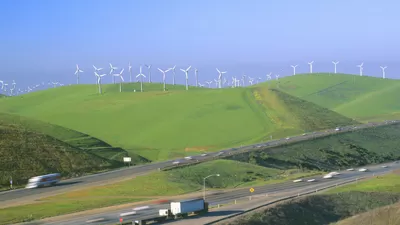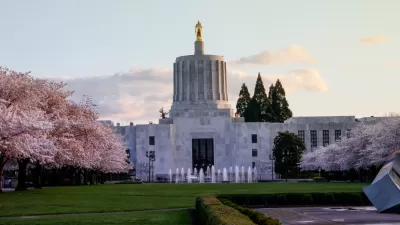The Oregon Climate Action Program, which would have priced carbon emissions by establishing a cap-and-trade program similar to the one in California, was defeated on Saturday, the penultimate day of the 2019 legislative session.

The Oregon legislature made history this session, which ended Sunday, by outlawing single-family zoning and making life easier for bicyclists by allowing them to treat stop signs like yield signs, but was unable to pass a critical climate bill despite having supermajority control of both chambers.
"This was the year for Oregon to enact the nation’s second economy-wide cap on greenhouse gases and reclaim her national environmental bona fides. Even Republicans acknowledged the inevitability," writes Ted Sickinger, an investigative reporter who has been chronicling the effort for The Oregonian, on June 30.
Democrats had a [three-fifths] supermajority in both houses. The governor, House Speaker and Senate President were all on board.
While that margin exceeded the supermajority requirement for bills that raise taxes, it was not clear whether that threshold was needed. In the end, it wouldn't matter when the bill reached the Senate.
"House Bill 2020 [which establishes the Oregon Climate Action Program] is one of the most complex and sprawling pieces of legislation ever to come before Oregon lawmakers, wrote Sickinger on June 17 after the bill passed the House on a 36-to-24 vote.
It envisions a wholesale reduction in Oregonians’ use of fossil fuels, and an associated decrease in greenhouse gas emissions equivalent to 80 percent below 1990 levels by 2050.
Republican walkout
The national media was captivated when Democratic Gov. Kate Brown authorized the Oregon State Police on June 20 "to retrieve the [11] Senate Republicans, who fled the Capitol in order to deprive the Senate of a quorum and block the likely passage of the carbon-reduction legislation," as reported by Nigel Jaquiss of Willamette Week.
However, Senate President Peter Courtney conceded on June 25 that there was disunity within Democratic ranks that would prevent the bill's passage, which led to the return of most of the Republican senators on Saturday after being on the lam for nine days.
"When Courtney banged down his gavel on the 17-10 vote [on Saturday], the biggest controversy of the 2019 session was over," reported Jaquiss on June 29. House Bill 2020 had died, and with it the opportunity for Oregon to join California, Quebec and Nova Scotia in the Western Climate Initiative.
What went wrong
"Democrats needed support from 16 of the 18 members of their Senate caucus in order to pass it," reported Sickinger and his colleagues on June 26 after Sen. Courtney divulged the bad news for supporters. Three Democrats were holdouts, some representing "districts where major employers were particularly opposed to the climate bill." Another issue that concerned lawmakers – the effect of the bill on gas and diesel prices.
Sickinger goes on to do an extensive political postmortem on the "complex 180-page bill, one that eventually had more than 100 proposed amendments."
Rewriting it to incorporate the first major round of changes – including deals Democrats cut with specific industries and interest groups -- took weeks. And in the end, the bill didn’t land for a final vote in the Senate until 11 days [June 19] before the constitutionally mandated close of the session.
A major point Sickinger makes is the urban-rural divide on climate policy, particularly when it comes to carbon pricing. A map of the districts of the 11 senators who walked-out makes that divide very clear, as its the overwhelming majority of the state, geographically speaking. [Scroll down to the image below "Republican senators’ districts" in the June 26 Oregonian article].
But outside the metro area, the concerns are real, rooted in past experience and the feeling that urban architects of the policy don’t truly care about the consequences on their way of life.
The coalition of supporters [including Renew Oregon] never had an effective spokesperson to counter that. It certainly wasn’t Gov. Kate Brown, who is not popular in rural reaches of the state. And not a single Republican lawmaker representing those districts took up the mantle.
However, the political divide between Republicans and Democrats exceeds the urban-rural split, according to a researcher cited by Sickinger.
Additional reading: "Cap and trade: What could Oregon’s carbon policy cost you?" June 19: Sickinger explains how the program would hike prices, particularly on transportation fuel.
“The bill makes the urban-rural divide stronger than ever because the biggest polluters are in Oregon’s large cities,” said Senate Republican Leader Herman Baertschiger, Jr., R-Grants Pass. “It is fundamentally inequitable to put the responsibility of cleaning up their pollution on the backs of rural Oregonians.”
Update from Associated Press, July 1: Gov. Kate Brown indicated she's prepared to use her executive power to have Oregon initiate the carbon cap-and-trade program by directing her staff to work with opponents in the rural parts of the state who were key to defeating the bill in the Senate, reports Sarah Zimmerman.
"Working on legislation is my preferred approach," she told reporters. "However, given the uncertainty that now permeates Oregon's political system, I am also directing my staff and agencies to explore alternative paths."
Related in Planetizen:
-
California Looks North for a Climate Partner, June 18, 2019
- Oregon Democrats Unveil Cap-and-Trade Bill, February 12, 2019
- Advocates for Oregon's Carbon Pricing Plan Proceed Cautiously, December 12, 2018
-
No West Coast Climate Bloc, November 7, 2018
FULL STORY: How Oregon’s climate-change bill ran out of gas

Alabama: Trump Terminates Settlements for Black Communities Harmed By Raw Sewage
Trump deemed the landmark civil rights agreement “illegal DEI and environmental justice policy.”

Planetizen Federal Action Tracker
A weekly monitor of how Trump’s orders and actions are impacting planners and planning in America.

How Atlanta Built 7,000 Housing Units in 3 Years
The city’s comprehensive, neighborhood-focused housing strategy focuses on identifying properties and land that can be repurposed for housing and encouraging development in underserved neighborhoods.

In Both Crashes and Crime, Public Transportation is Far Safer than Driving
Contrary to popular assumptions, public transportation has far lower crash and crime rates than automobile travel. For safer communities, improve and encourage transit travel.

Report: Zoning Reforms Should Complement Nashville’s Ambitious Transit Plan
Without reform, restrictive zoning codes will limit the impact of the city’s planned transit expansion and could exclude some of the residents who depend on transit the most.

Judge Orders Release of Frozen IRA, IIJA Funding
The decision is a victory for environmental groups who charged that freezing funds for critical infrastructure and disaster response programs caused “real and irreparable harm” to communities.
Urban Design for Planners 1: Software Tools
This six-course series explores essential urban design concepts using open source software and equips planners with the tools they need to participate fully in the urban design process.
Planning for Universal Design
Learn the tools for implementing Universal Design in planning regulations.
Jessamine County Fiscal Court
Caltrans
Institute for Housing and Urban Development Studies (IHS)
City of Grandview
Harvard GSD Executive Education
Toledo-Lucas County Plan Commissions
Salt Lake City
NYU Wagner Graduate School of Public Service





























